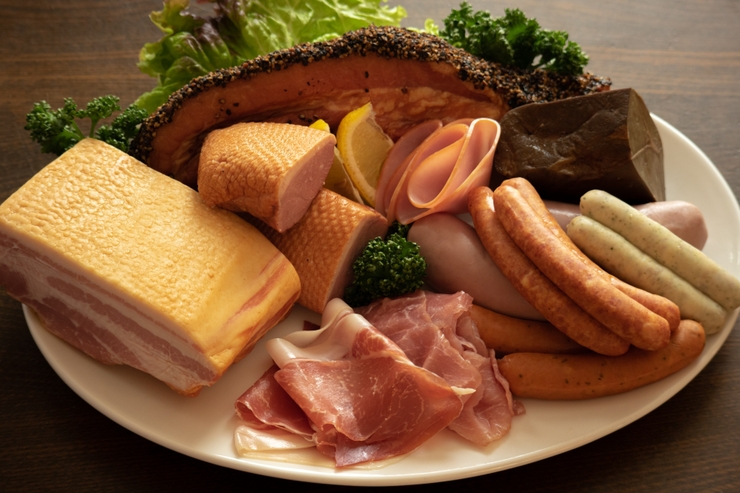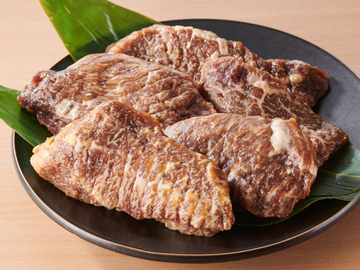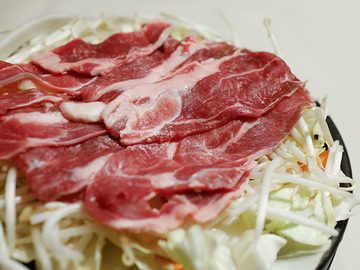Processed livestock products

This page introduces livestock processed products of Japan, roughly divided into meat (pork, beef, chicken, etc.), eggs, dairy products, and other processed products (such as honey).
History and culture
[Meat]
There is a wide array of processed livestock products that are available. Some common examples are salted, dried, smoked products, ham, sausage, and canned products.
Eating meat was freely practiced in primitive and ancient Japan, and many wild animals, especially boar and deer, were viewed as sources of food. Furthermore, it has also been noted that pigs (domesticated boars) had been raised and used for food since ancient times.
As Buddhism arrived in Japan in the 6th century, a movement to ban eating animals became prevalent, and during the era of Emperor Tenmu, a decree prohibiting killing animals such as cows, horses, monkeys, fowl, and dogs was issued. As this decree was issued during the busy farming season between the first day of April to the end of September, some say that it was not based on Buddhist ethics but instead to stabilize the production of rice. Although decrees against killing animals continued on by various emperors after this, eating meat was not completely denied even after medieval Japan, and it is said that the practice continued on between commoners.

After Christianity, which did not prohibit eating meat, was introduced through exchanges with Nanban-jin (Western Europeans) in pre-modern Japan, the number of people converting to Christianity grew in the Kyushu area, which was the center for trade with Spain and Portugal, and with it, the number of people eating meat also increased. Furthermore, local cuisine influenced by foreign dishes using pork and chicken became established throughout Kyushu, and these foods are still being passed down to this day.
Eating meat started to genuinely take root only after Japan opened itself to the world at the end of the Edo era. As more exchanges with Westerners were made, eating meat became a valued method to improve one's physique, and beef hot pot restaurants became popular in urban areas. As reports of the emperor eating meat were made and meat was incorporated into military meals, beef in particular was enjoyed by the general public as a symbol of civilization and development. Furthermore, after the Meiji era, domestic production of processed meat products such as ham and sausage also started with the efforts of foreign technicians.
[Eggs]
Currently, Japan is a chicken egg powerhouse as the world's second largest consumer of eggs per capita after Mexico (as of FY2021*). However, as with meat, eggs were not actively consumed until the Edo period due to Buddhist philosophy influences. There are even Heian era documents stating that consuming eggs would bring about misfortune.
However, as the country entered the Azuchi-Momoyama era, European dishes using eggs such as tempura and castella were brought into the country and gradually became highly prized as nourishing dishes. Furthermore, it is said that farmers would collect eggs from their yards and sell boiled eggs. In the 5th year of the Tenmei era (1785), the "Manbo Ryouri Himitsubako" was published with various egg recipes including those for shredded omelets, egg tofu, and egg porridge. Although there were already egg peddlers in this era, eggs remained expensive and a valuable commodity for the common citizen.

Although books and other publications promoting poultry farming were published for general households as the ban for eating meat was lifted in pre-modern Japan, eggs retained their image as a luxury health product even after World War II. Nevertheless, introduction of broiler chickens and Westernization of the Japanese diet progressing into the 1950s had people reevaluating the nutritional value of eggs, and eggs started to establish themselves as a household staple around this time. The trendy phrase in the 1960s was "Kyojin (baseball team), Taiho (sumo wrestler), and egg rolls", proof of how egg rolls had become a beloved dish in home cooking.
* According to 2021 statistics by the International Egg Commission (IEC).
[Dairy products]
In regions around the world, fermented foods born in that local environment have made a place for themselves.
The history of dairy products in Japan goes back to the 6th century. Medical books brought to Japan by Chiso visiting from Baekje (an ancient Korean kingdom) was said to document the medicinal properties of milk and how to raise cows for dairy, and this is believed to be the pioneer of record keeping. Chiso's descendants were instrumental in establishing the foundation for dairy processed products in Japan, as they continued their efforts in contributing milk and dairy products to the Imperial Court and ran cattle farms and Nyugyuin.
Furthermore, the Heian era's "Wamyo Ruijusho" dictionary introduced dairy products such as "raku (yogurt), so (dairy product made from layers of milk skin), daigo (ghee), and rubin (cheese)", and various dairy products in caramel and cheese-like forms have been confirmed to already exist during this time. However, although dairy products were valued as medicinal products in the Heian aristocracy, they disappeared from records from medieval Japan and forward, due to the manorialization of state-owned farms and the growing trend of avoiding animal products under Buddhist philosophy.

Interest in dairy products made a revival in the Edo era. According to records, the 8th shogun, Tokugawa Yoshimune, established a farm in Mineokamaki in Awa (currently the cities of Kamogawa and Minamiboso in Chiba Prefecture) in the Kyoho Period (1716-36), and started raising white cattle. "Hakugyuraku", which boiled down and dried the milk of these white cows were valued as nutritional food. As time went on into the Meiji era, people started to appreciate the benefits of milk and dairy products with the development of medicine and hygiene, and it became apparent that dairy products were gradually being considered as household commodities. Especially in the early Meiji era, the use of cow milk as a substitute for breast milk started to become popular, and books on boiling methods and safe feeding were published along with books for manufacturing cheese and butter, as dairy farming technology from the West started to be introduced.
In the late Meiji period, influences by the research of the Russian microbiologist Metchnikoff confirmed claims recognizing yogurt, and sales of yogurt gradually started within the country. Furthermore, in 1930, a doctor named Minoru Shirota discovered the Shirota strain in lactic acid bacterium, enabling the development of Japan's original lactic acid bacteria beverages to progress.
However, the all-out spread of dairy products in Japan came only after the end of the war. This rapid economic growth brought about Westernization of the Japanese diet, and dairy products such as butter, cheese, and yogurt became common within the daily lives of Japanese people all at once.
[Other (honey)]
The first description of "beekeeping" in Japanese history can be traced back to the "Nihon Shoki" (Chronicles of Japan). According to the Nihon Shoki, it is noted that in year 643, "Yoho from Baekje attempted beekeeping at Mt. Miwa in Nara but failed". However, honey continued to exist as offerings from foreign countries even after the Nara period and for a long time was considered as a valuable good.

It is said that beekeeping did not become a full-fledged practice until the Edo era, and books on beekeeping techniques, along with classification and benefits of honey, were published during this era. Among these, the "Kachiku Chikuyouki" published in 1791 is considered to be one of the first books to detail the ecology and farming techniques of the Japanese honeybee. From the Meiji era onward, overseas import of bees started, and migratory beekeeping spread through the country, expanding the beekeeping market.
Honey has an extremely high sugar content and low water activity values. Furthermore, honey is acidic and has properties that make it difficult for putrefying bacteria to propagate. It is a processed product that has an excellent shelf life.
Characteristics and types
To this day, "Omi beef preserved in miso", a traditional food in which beef is pickled in miso and aged, has been passed down through the years since the Edo era, when eating meat was prohibited. At that time, the Hikone Clan (of Shiga Prefecture) was the only clan authorized to slaughter cattle, as the clan offered cow hides to the shogunate government to be used as war drums. In this backdrop, the "kusurigui" practice of eating under the pretext of nourishment and revitalization was invented, and this food was offered to the reigning shogun as restorative medicine.

Progress in meat processing technologies was made after the Meiji era, as exchanges with Western countries became more active. Along with the introduction of slaughter techniques, development on processed food manufacturing techniques also progressed, and the first production of ham in Japan started in 1872, when Kataoka Iemon of Nagasaki Prefecture learned how to make ham from Americans. At the same time, ham manufacturing by an English technician William Curtis started in Yokohama as well. Furthermore, in the Taisho era, the influence of German technicians who had come to Japan with the World War I led to authentic German methods of manufacturing ham spreading throughout the country.
Canned "beef tsukudani (food boiled down in soy sauce)" carried as rations in the Seinan War in 1877 is said to be the first instance of canned animal meat, and canned "beef yamatoni" based on tsukudani cans and seasoned in a Japanese style was developed in 1888. These "yamatoni" cans were valued as rations for the armed forces and established itself as a non-perishable food in general Japanese households later on.
[Eggs]
Egg dishes first appeared in the Edo era, as there was no custom of eating eggs for an exceptionally long time in Japan. Trade with Spain and Portugal popularized eating chicken eggs. However, chicken eggs were still a rare delicacy at that time. Despite this, Japan had already given birth to unique chicken egg dishes in the Edo era. For instance, the "tamago fuwafuwa", which is said to have been served at Fukuroi-juku (a station on the Tokaido route), is also said to have been on the breakfast menu for guests staying at the Ota Waki Honjin (a sub-station on the Nakasendo route), according to an Edo period document "Sendai Geko Nikki". This dish is made by pouring beaten eggs into boiling soup stock and steamed until completed. Some believe that this dish developed to create "tamagoyaki (eggrolls)" which are thickly cooked omelets with soup stock and sugar.

Nagasaki had many overseas food culture influences, and many egg dishes were introduced to this region. For example, "Arumado" is a paste containing an egg brightly colored with red food coloring. Its quirky name is said to come from the Dutch word "almatore (to wrap)" or the Portuguese word "armado (to arm)".
Mayonnaise, which is a semi-solid dressing created from egg yolks, vegetable oil and vinegar, is said to originate from the sauce served with meat at a restaurant in Port Mahon, Menorca during the French invasion of the island in the mid-18th century, which was introduced as a "Mahon sauce" later in Paris. Mayonnaise was commercialized in Japan in 1925 by Nakashima Shoten. Meanwhile, there is a seasoning unique to Japan called "kimizu", which uses egg yolk and vinegar, the same as mayonnaise, and has been handed down for generations since the Edo era.
[Dairy products]
Milk and dairy products came over to Nara Prefecture from Tang during the Asuka era and was mainly consumed by aristocrats but were also secretly spread among monks. The monks did not only drink milk, they also started to simmer their chickens with milk for their meals. This dish is said to be the origin of the "asukanabe" (a dish in which chicken and vegetables are simmered with milk and soup stock) which still exists to this day.

"So" is a processed food created from milk boiled down over an extended time. It has a long history and even makes an appearance in "Engishiki" (Procedures of the Engi Era) compiled in the Heian era. However, this food was valued as a delicacy for aristocrats during that era and out of the commoners' reach. In 1987, this food was commercialized by Nishii Farm (Nara Prefecture). So is also described as being ancient cheese.
"Chikko tofu/milk tofu" is a food of the cities of Kamogawa and Minamiboso of Chiba Prefecture, where Japanese dairy farming is said to have originated, and is made from bovine colostrum from cows after birth. As it has a short shelf life, it was not sold but enjoyed among dairy farmers. In the present day, this food is processed in various ways with heated milk, and widely consumed by the general public.
[Honey]
The composition of honey is approximately 80% sugar and 20% water, and it also contains traces of active ingredients such as vitamins and minerals and features diverse flavors and colors according to the plant nectar. It is used as a sugar alternative, along with manufacturing and seasoning sweets. Other various uses for honey include alleviating odors of food ingredients, creating mild textures, and locking in Umami. Furthermore, its non-spoiling properties are used for processed products such as pickling plums, various fruits, and nuts.



